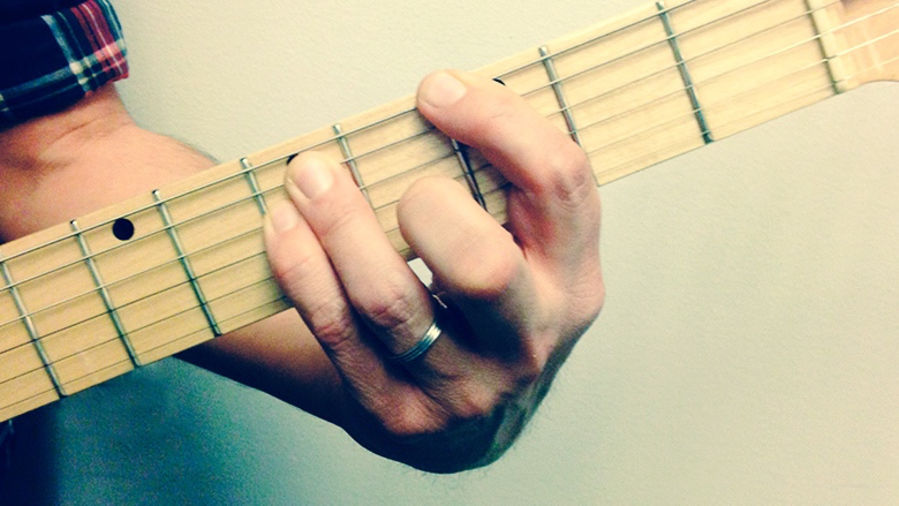How to Develop Picking Control With Accented Scale Practice
These accent patterns can be used to raise your level of rhythmic and right-hand awareness when practicing scales.

Working on scales in the practice room can sometimes seem like a one-handed event.
Sure, the picking hand is there, and it may even be focusing on alternate picking, sweep picking or other picking technique, but beyond that, how deep do we really go with our right hand when practicing scales?
In order to bring more focus onto building right-hand control and dexterity, I like to practice and teach the use of accent patterns when running any scale in the practice room. Accent patterns are not only a great way to develop right-hand technique, but they also bring a rhythmic element into the picture, keeping you focused on picking technique throughout any scale exercise that you are spending time on in the practice room.
The following examples are four accent patterns that can be used to raise your level of rhythmic and right-hand awareness when practicing scales, as well as provide you with rhythmic variety in both your technical practice and real-life situations as you bring these ideas into your lines on stage or in the practice room.
For this lesson, I have written out each accent patterns over a two-octave G major scale in first position. Feel free to take these exercises to any scale in any key that you are working on in the practice room.
Accenting First Note
In this first exercise, you will play up and down the scale while accenting the first note of each four-note group. In this case, you will put accents on beats 1 and 3 of every bar.
All the latest guitar news, interviews, lessons, reviews, deals and more, direct to your inbox!
The hardest part about these exercises is not really playing one note louder in each four-note group; it is playing the other three notes softer, and at the same volume level. This is where you will really develop right-hand control and accuracy. So go slow and make sure that the three softer notes are not only quieter than the accented note, but that they are all played at the same volume level.

Accenting Second Note
You can now move forward by accented the second note in each four-note group. This is going to be trickier than the first exercise as you are now accenting upbeats in each group, the "and" of 1 and the "and" of 3.
As well, you need to play the first, third and fourth notes at the same volume, this tough because there is now an accented note between the three quieter notes, making you focus extra hard on keeping those three notes at the same volume level each time.

Accenting Third Note
The third accent is found on beats 2 and 4 of the bar, the third note of each four-note grouping. When playing this exercise make sure to use a metronome on either beats 1 and 3, or on all four beats.
Sometimes with this accent pattern you will “flip the beat,” meaning that the accented notes will become 1 and 3 instead of 2 and 4 as your ears try and place them at the start of the bar. Using a metronome will avoid this from happening and fix any “flipping” issues that may arise during the course of the exercise.

Accenting Fourth Note
The final accent will fall on the fourth note of each four-note group, the "and" of 2 and 4 in each bar. This is my favorite accent pattern to practice as it really works on your syncopation and creates a forward motion in your lines that builds energy and propels your scales, or lines in a solo, forward as you ascend and descend each pattern.

As guitarists we spend a lot of time practicing scales and left-hand patterns, but sometimes the right hand gets left behind as we focus on learning harmonic and melodic vocabulary. By inserting accents into your scale practice, you will not only develop your rhythmic pallet but will raise your level of right-hand control and dexterity at the same time that you expand your scale knowledge.
A win-win-win situation if there ever was one.
Matt Warnock is the owner of mattwarnockguitar.com, a free website that provides hundreds of lessons and resources designed to help guitarists of all experience levels meet their practice and performance goals. Matt lives in the UK, where he is a senior lecturer at the Leeds College of Music and an examiner for the London College of Music (Registry of Guitar Tutors).
Matt Warnock is the owner of mattwarnockguitar.com, a free website that provides hundreds of lessons and resources designed to help guitarists of all experience levels meet their practice and performance goals. Matt lives in the UK, where he teaches Skype guitar students all over the world, and is an examiner for the London College of Music (Registry of Guitar Tutors).
